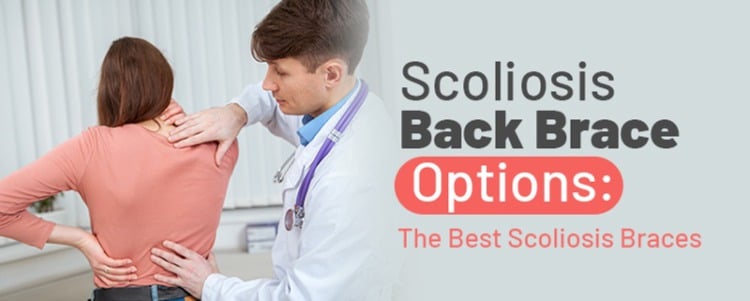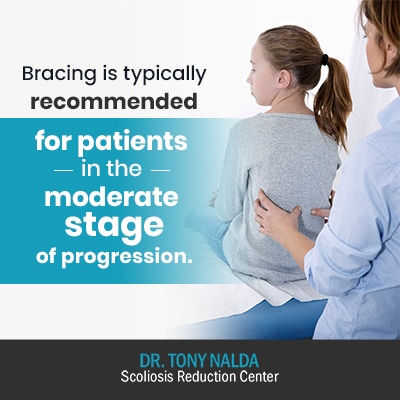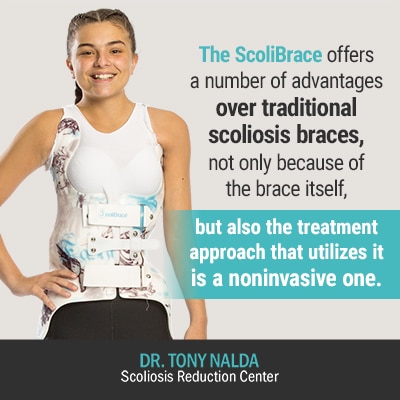
For the condition’s most common form, adolescent idiopathic scoliosis, the multifactorial nature of the condition necessitates an integrative and customized treatment plan. Different treatment approaches, including different types of back braces, offer patients different outcomes, which is why it’s so important to ensure that treatment expectations are aligned with the reality of the chosen treatment approach.
There are many scoliosis back brace options, but not all are created equal. Traditional braces, like the Boston brace, have stopping progression as its end goal, while corrective braces, like the ScoliBrace, have correction, or reduction, as its end goal; how these end goals are achieved affects the spine’s function.
There are two main treatment approaches for patients, and their families, to choose between: traditional and functional vs modern scoliosis braces. These different approaches use different types of back braces that reflect the key difference between an approach that prioritizes stopping progression, or one that works towards a curvature reduction, while preserving function. Before we move on to the specifics of different scoliosis back braces, let’s talk about the two main treatment approaches in general terms.
Table of Contents
As mentioned, the two main scoliosis treatment approaches to choose between are traditional and functional, each offering a different potential outcome.
As scoliosis is a spinal condition that involves having an abnormal sideways curvature, with rotation, the general goal of treatment is to realign the misaligned spine, restoring its healthy curves, function, and overall health. However, the means by which that is achieved, treatment-wise, carries very different outcomes in terms of the spine’s overall health and function.
The traditional approach is one that has been in place for many years, but it is more reactive than proactive. What this approach involves is a lot of passive watching and waiting.
As scoliosis is progressive, throughout its phases of progression, it can be classified as mild, moderate, severe, or very severe. For conditions that are diagnosed in the mild stage of the progressive line, those following the traditional approach are often told to simply observe the condition to see if it progresses.
Patients would return for X-rays at predetermined intervals to see whether or not the curvature has increased in size; the issue I have with this is that it’s wasting valuable treatment time while potentially allowing a curvature to progress unimpeded.
As we know scoliosis is progressive, we know it’s going to get worse at some point, so why not be proactive and deal with it when the curvature is smaller, less complex, less rigid, and easier to treat before the body has adjusted to its presence?
On the traditional path of scoliosis treatment, if progression is occurring, the only form of treatment, prior to crossing that surgical-level threshold, is bracing, the specifics of which we’ll return to later.
Ultimately, the end goal of traditional scoliosis bracing is stopping progression, which is the same as the end goal of spinal-fusion surgery. It’s important for patients, and their families, to understand that merely stopping/slowing progression is different than working towards a curvature reduction that preserves the spine’s overall strength, function, and health.
While the traditional approach and spinal fusion can be successful in terms of straightening a crooked spine, how those results are achieved can have far-reaching consequences, especially in terms of the spine’s function.
A spine that’s held in a corrective position by unnatural means, such as with rods and screws attached to the spine in spinal fusion, is not the same as working towards a curvature reduction through proactive treatment that impacts the condition on a structural level, and strengthens the spine and its surrounding muscles so that it can be naturally supported and stabilized.
As you can likely guess, I’m a believer in a functional approach to scoliosis treatment. While stopping/slowing progression is an important part of my treatment plans, I want to reach those goals in a way that preserves the spine’s natural strength and function.
A functional approach prioritizes the spine’s overall function by maintaining as much spinal flexibility as possible, strengthening the spine itself, and increasing core strength so the spine’s surrounding muscles are better able to support and stabilize it, facilitating the spine’s ability to maintain its natural and healthy curvatures.
I believe that while a traditional approach might be able to reduce a curvature more significantly, how it is achieved comes at a price, and I don’t think it takes into consideration giving patients the best possible quality of life with their condition.
I don’t want the spine merely ‘held’ in a corrective position through artificial and invasive means, I want the spine to experience a structural reduction, along with strengthening its supportive muscles for sustainable results.
Here at the Scoliosis Reduction Center, all forms of treatment we offer, including bracing, have the end goal of curvature reduction and function, which shows in the impressive results we can achieve.
Treatment is a process that requires hard work and commitment, but when those first positive results are seen, the motivation to keep working towards improvement is strong.
My functional approach is also integrative, meaning I combine multiple treatment disciplines so my treatment plans can be fully customized to the patient and their condition.
No one discipline on its own would be enough to treat scoliosis, bracing included, but when multiple forms of treatment are combined in such a way that they work together and complement each other, there are fewer limits to what we can achieve.
Through a combination of chiropractic care, in-office therapy, custom-prescribed home exercises, and specialized corrective bracing, I can work towards reducing a patient’s curvature, preserving their spinal function, and help them avoid surgery.
Following is what you need to know about scoliosis bracing.
The most prevalent form of scoliosis is adolescent idiopathic scoliosis (AIS), affecting millions of young people around the world.
In many cases of AIS, a young person’s life is altered in multiple ways, especially in terms of restrictions placed on physical activity, which can have profound effects, especially for those who define themselves by the sports they place or activities they love.
Again, in many cases, traditional treatment is passive, with doctors taking a watch-and-wait approach which yields no actual improvement and places more restrictions on patients. Eventually, those young patients would likely be fitted with a traditional back brace, such as the Boston brace.
 Bracing is typically recommended for patients in the moderate stage of progression.
Bracing is typically recommended for patients in the moderate stage of progression.
Just as the traditional approach has been in place for many years, so too has the use of traditional back braces in treating AIS; however, these types of braces are highly ineffective when it comes to actually reducing an abnormal spinal curvature.
At best, they might prevent further progression, but of course, there are never guarantees, and unfortunately, many of the patients who have been fitted with traditional braces still end up progressing to the point where surgery is recommended as their best option.
Surgery is costly, invasive, and can carry a lot of heavy potential side effects and risk of complications, not to mention that the straighter spine comes at the cost of its overall health and function.
It’s important for patients and their families to understand that just as there are different treatment-approach options, there are also different bracing options that achieve different results.
There are three main types of traditional scoliosis braces used: the Boston brace, the Charleston bending brace, and the Milwaukee brace.
The Boston brace is the most commonly-used scoliosis brace for children and adults in the United States and is a type of TLSO brace (Thoracic-Lumbo-Sacral-Orthosis), and it focuses on curvatures in the thoracic and lumbar sections of the spine.
Its end goal is to stabilize a scoliotic curve so that it does not increase in size. The brace was designed in the 70’s and has evolved very little since then, despite the fact that we know a lot more about the condition, currently, than we did in the past.
The Boston brace is mass-produced and made out of hard durable plastic that wraps around the patient’s rib cage, hips, and lower back. As the brace is mass-produced, it is not customized to address the specifics of a patient’s body type, curvature, type, and/or curvature location.
Even if the brace fits well, it’s not designed to actually correct, but rather hold the spine in a corrective position. In addition, the brace has to be worn full time, meaning 18 to 23 hours a day for up to five years.
The end goal of this type of brace is to squeeze or compress the scoliotic curve in a way that stops the curvature from progressing further. It does this by using specifically-placed pads to apply pressure to corresponding sites of the curvature, with a relief area placed opposite the pad. Basically, the pad squeezes the spine as part of a ‘three-point pressure system’.
If stopping progression is the main goal of treatment, the Boston brace does have the potential to do this, but again, that’s different from working towards corrective results.
There are also other types of scoliosis braces that are meant to be worn at night during sleep, such as the Charleston bending brace.
The Charleston bending brace was also designed in the 70’s. The idea behind this brace is to help adolescents reduce thoracolumbar curves during sleep. This brace was developed, in part, to address the challenge of compliance associated with the Boston brace.
The brace’s design allows the pelvis to be manipulated and enhance the effects of some of the lower back’s curvatures. The brace is molded in a way that conforms to the patient’s body while they are in a position of bending towards the outward bulge of their scoliotic curve, in an effort to overcorrect the curvature.
Many question how effective a brace that is only worn during sleep can be, and this brace only addresses the bending component of scoliosis, not its rotational component.
Other nighttime braces with similar designs and end goals include the Providence brace and the Wilmington brace.
The Milwaukee brace is a CTLSO (Cervico-Thoraco-Lumbo-Sacral) brace that’s generally prescribed to address curvatures of the middle back.
Like the Boston brace, its design is cumbersome as it extends from the neck down to the pelvis. There is a neck ring and pelvic girdle connected by metal bars that are as long as the torso and help keep the head centered over the pelvis.
Also like the Boston brace, the Milwaukee uses strategically-placed pads to squeeze the spine and stop progression.
As the Milwaukee brace uses the same squeezing principle as the Boston, its results are similar: squeezing the spine into a corrective position.
So what are some of the problems associated with these traditional types of scoliosis back braces?
Despite how common using traditional scoliosis braces are in treatment, if they’re not corrective, and/or aren’t combined with other effective forms of treatment, they are relatively ineffective.
The main problem with traditional bracing options is that they don’t address the true 3-dimensional nature of the condition. While the Boston brace, when worn full time, does have the potential to address progression, the way it does that, by squeezing the spine over time, can actually weaken the spine and abdomen, potentially causing greater problems in the future.
As it’s designed to squeeze the spine, without any efforts being made to stabilize and support it, the end result can be a weaker and more-rigid spine.
Braces that use a three-point-pressure system squeeze the spine from the side, which can also lead to worsening rib irregularities associated with scoliosis.
Patients who have worn traditional scoliosis braces have reported experiencing the following issues:
While there most certainly is a place for scoliosis braces in effective treatment plans, not all braces are created equal, and bracing alone won’t be enough in terms of achieving a structural curvature reduction with long-term sustainable results.
The ScoliBrace is a positive alternative to the traditional scoliosis braces used as it’s corrective, achieves its results through different means, and addresses the condition’s 3-dimensional nature.
When it comes to scoliosis management, finding the right scoliosis back brace is crucial. A brace for scoliosis, such as the innovative Scolibrace, can provide effective support and help halt the progression of the spinal curvature. This is particularly vital for children with scoliosis, as their growing bodies may benefit greatly from child scoliosis brace options. Exploring the range of children's scoliosis brace choices is essential in ensuring a comfortable and successful experience for young patients seeking to manage their condition.
The ScoliBrace represents the culmination of what we have learned about scoliosis and scoliosis bracing over the years.
While the traditional braces still have a place in scoliosis treatment and were, at one time, considered innovative approaches to scoliosis treatment, they most certainly are not today; instead, there is the ultra-corrective ScoliBrace that features an ingenious design and concept.
The ScoliBrace can actually reduce a curvature, while preserving function, by addressing its 3-dimensional nature, as traditional braces do not.
Scoliosis is a highly-complex spinal condition. Working to reduce it to two dimensions (left to right or forward to backward) is ignoring the whole picture of what’s happening to the spine.
Fortunately, more modern corrective bracing, like the ScoliBrace, can be highly effective because it addresses all aspects of the abnormal spinal curvature: the bend and the twist.
When the ScoliBrace is combined with other effective scoliosis-specific treatment disciplines such as chiropractic care, in-office therapy, and custom-prescribed home exercises, curvatures can be reduced significantly, and not at the cost of the spine’s overall health and function.
So what exactly, other than the end goal of actual correction versus stopping progression, makes the ScoliBrace so much more effective than traditional braces?
 The ScoliBrace offers a number of advantages over traditional scoliosis braces, not only because of the brace itself, but also because the treatment approach that utilizes it is a noninvasive one.
The ScoliBrace offers a number of advantages over traditional scoliosis braces, not only because of the brace itself, but also because the treatment approach that utilizes it is a noninvasive one.
The traditional approach, as mentioned, is not particularly proactive; it’s more about passively observing, then reacting first with traditional bracing in the moderate stage, and then often with a surgical recommendation once that surgical-level threshold has been passed.
A traditional approach has the end goal of stopping progression, not actually correcting the scoliosis. The functional approach, as also mentioned, is proactive. It involves starting treatment as close to the time of diagnosis as possible in the hopes that higher levels of progression, and the need for surgery, are never reached; it’s end goal is curvature reduction and function.
The ScoliBrace is super-corrective, meaning it positions the spine in an opposite mirror image of itself, allowing for the reduction of curves while making improvements to related postural changes such as uneven shoulders, rib arches, and the condition’s overall asymmetrical effect on the body. It can address a rib arch effectively because it is a custom brace, designed specifically for the patient.
The ScoliBrace uses modern 3-D scanning technology (BraceScan) to custom-fit and design each brace to specifically suit the wearer’s body and curvature type, making it more comfortable and less cumbersome to wear.
In addition to BraceScan technology, additional condition information goes into a ScoliBrace design such as posture photos, X-ray images, and CAD (computer-aided design).
The ScoliBrace is designed with aesthetics in mind; considering the age group of the majority of patients wearing braces (adolescents), this is an important factor that improves compliance. The brace easily opens and closes in the front and comes in a wide variety of colors and patterns.
While no result is ever guaranteed, the ScoliBrace, when used in conjunction with other effective scoliosis-specific treatment disciplines, has the potential to reduce curvatures and improve posture.
When it comes to scoliosis back brace options and determining the best scoliosis braces, the answer will depend upon the desired treatment outcome.
When adolescents face a scoliosis diagnosis, it’s given during an already tumultuous time. The adolescent and teen years can be filled with uncertainty, and for these young people to have to deal with a progressive spinal condition can pose many additional challenges, both physical and emotional.
One of the main challenges I’ve seen patients struggling with along the path of traditional treatment are the limitations placed on them during a time of life that should be filled with possibilities.
While traditional braces like the Boston, Charleston, and Milwaukee can help prevent a curvature from progressing, the way it is achieved, by squeezing the spine, can cause further problems and limitations during and after treatment.
Traditional bracing methods are about limiting movement to impact the movement (progression) of the curvature. The braces are cumbersome and uncomfortable, limiting many aspects of a young person’s life and causing potential compliance issues.
Spinal fusion, which can be thought of as a form of internal bracing, also places many limits on patients as preserving the spine’s overall health and function are not the end goals of treatment, stopping progression is.
Here at the Scoliosis Reduction Center, I rely on the ScoliBrace because I feel it places fewer limits on patients during and after treatment. When bracing is necessary and we combine the ultra-corrective ScoliBrace with scoliosis-specific chiropractic care, in-office therapy, and custom-prescribed home exercises, patients can see results in as little as two weeks of treatment.
As the ScoliBrace addresses the true 3-dimensional nature of scoliosis and pushes the spine, instead of squeezing it, the brace doesn’t weaken the spine or impair its function. The ScoliBrace is a new brace for a new era of scoliosis correction, one with the potential to offer more than simply managing the condition.
